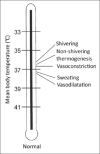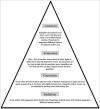Temperature management under general anesthesia: Compulsion or option
- PMID: 29109627
- PMCID: PMC5672515
- DOI: 10.4103/joacp.JOACP_334_16
Temperature management under general anesthesia: Compulsion or option
Abstract
Administration of general anesthesia requires continuous monitoring of vital parameters of the body including body temperature. However, temperature continues to be one of the least seriously monitored parameters perioperatively. Inadvertent perioperative hypothermia is a relatively common occurrence with both general and regional anesthesia and can have significant adverse impact on patients' outcome. While guidelines for perioperative temperature management have been proposed, there are no specific guidelines regarding the best site or best modality of temperature monitoring and management intraoperatively. Various warming and cooling devices are available which help maintain perioperative normothermia. This article discusses the physiology of thermoregulation, effects of anesthesia on thermoregulation, various temperature monitoring sites and methods, perioperative warming devices, guidelines for perioperative temperature management and inadvertent temperature complications (hypothermia/hyperthermia) and measures to control it in the operating room.
Keywords: Hyperthermia; hypothermia; inadvertent; intraoperative; temperature; thermoregulation.
Conflict of interest statement
There are no conflicts of interest.
Figures








References
-
- Moola S, Lockwood C. Effectiveness of strategies for the management and/or prevention of hypothermia within the adult perioperative environment. Int J Evid Based Healthc. 2011;9:337–45. - PubMed
-
- Poulos DA. Central processing of cutaneous temperature information. Fed Proc. 1981;40:2825–9. - PubMed
-
- Jessen C, Feistkorn G. Some characteristics of core temperature signals in the conscious goat. Am J Physiol. 1984;247(3 Pt 2):R456–64. - PubMed
-
- Jessen K. An assessment of human regulatory nonshivering thermogenesis. Acta Anaesthesiol Scand. 1980;24:138–43. - PubMed
-
- Kellogg DL., Jr In vivo mechanisms of cutaneous vasodilation and vasoconstriction in humans during thermoregulatory challenges. J Appl Physiol. 2006;100:1709–18. - PubMed
Publication types
LinkOut - more resources
Full Text Sources
Other Literature Sources
Medical

